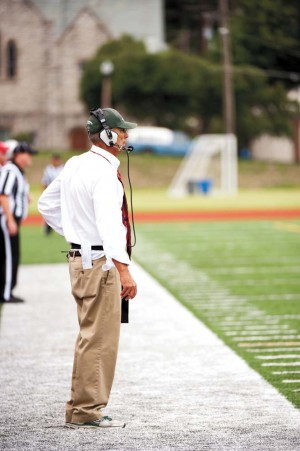Sports
The pitch to Wash. U. athletic recruits
Head football coach Larry Kindbom looks on as his team takes on Coe College on Sept. 15, 2012. Kindbom is in his 24th season as head coach at Washington University.
One week ago, the college football landscape was fixated on one of its favorite days of the year: national signing day. Top recruits around the country donned caps with their new school’s logo, ready to play in the spotlight for some of NCAA Division I football’s best programs—from the University of Alabama to the Ohio State University to, apparently, the University of Mississippi—beginning next fall.
While that was happening, Washington University football coach Larry Kindbom followed along, knowing that his recruiting cycle wasn’t even close to done yet. As you might know, there aren’t scholarships or letters of intent in Division III college sports. If people want to play at Wash. U., they have to get accepted like everyone else.
So Kindbom’s recruiting season gets really interesting around March, when regular-admission students begin to get their acceptance or rejection letters. And that wait can lead to a problem with certain recruits.
“Our timeline doesn’t always jive with Division I,” Kindbom said. “And not just Division I, but the scholarship schools, and other schools like us that are now using the admissions tool, saying, ‘We can get you in if you say yes to us now.’ That’s not Wash. U.
“Signing day was this past week, and [they] would rather go to Washington University if they can get in. So these kids are pressed with some very, very difficult decisions because the calendars are so very different.”
Kindbom’s no stranger to the recruiting process of college sports’ biggest showcase. He worked at Ohio State as a graduate assistant from 1977-79 before serving as an assistant coach at the University of Akron from 1979-83. Not surprisingly, things are a little bit different at those places.
“The difference,” Kindbom said, comparing Wash. U. to those two schools, “still came down to ‘when you come here, understand that football was first.’ That had to be understood.”
And that mentality is what ultimately led him to the Division III level—first for six years at Kenyon College before starting at Wash. U. in 1989.
“Now, my feeling is, when I was [at the Division I level], I understood that was what it was all about. For me to say ‘I just didn’t believe in that’…when I was there, I had to believe in that. And I didn’t want to be in that situation. Part of the reason I am where I am is because I didn’t think that I was most comfortable working in a situation where football was the No. 1 thing.”
And while football, or whichever other sport, is the No. 1 thing for thousands of recruits across the country, the pitch of the Wash. U. coach makes the sport a priority, rather than the priority.
Volleyball head coach Rich Luenemann, for instance, has had his share of recruiting seasons to work with—and thanks to the pedigree of the volleyball program and its 10 national championships, he often is making the Wash. U. pitch to Division I-quality recruits.
“On occasion, prospects who are being recruited by Division I universities elect to matriculate to Wash. U.,” Luenemann said. “They do so because of the incredible academic opportunities, the student-centered university focus and the fact athletic participation here isn’t a job or lifestyle.”
Kindbom echoed a similar sentiment, celebrating the success of his players to be able to excel at football and also have the same college experience here as anyone else.
“We want guys who want to play for championships. We’re playing one of the toughest schedules in the country, and that’s a selling point—[but] you’ll still be able to do the things that you want academically.”
Kindbom pointed out that the top major on the football team last year was biomedical engineering, and Luenemann noted that the “proof is in the pudding in that our student-athletes exhibit the same dissemination of majors as the non-athletes, and their GPAs are very similar.”
There were more parts of the appeal, such as the fact that athletes like football players are able to go abroad in the spring where they wouldn’t be able to at a scholarship program. And this has worked out well for student-athletes and coaches alike—Kindbom has asserted that his players who go abroad have been able to contribute even more than before as they’ve stayed dedicated to the program when not in St. Louis.
“They know that to win a position, they’ve got to come back in better shape. They’ve got to come back ready to go,” Kindbom said. “This is a competitive program. They feel so good about it in the first place—those guys almost always come back bigger, stronger, faster.”
Ultimately, that theme ties into what Kindbom seemed to define as the all-encompassing Wash. U. recruiting pitch to quality student-athletes. Athletes who head into high-level scientific research or get jobs on Wall Street or are accepted to medical school aren’t exceptions—they’re students.
“It’s cool that a Wash. U. student can do [those things], but the fact that the Wash. U. athlete not only can do that but does that…how cool is that?” Kindbom said. “And that’s across the board, in all sports. And that’s what I think makes this place special. I think it just means that, of those athletes, they can do that in their college careers, and it just makes them want to play even harder.”

